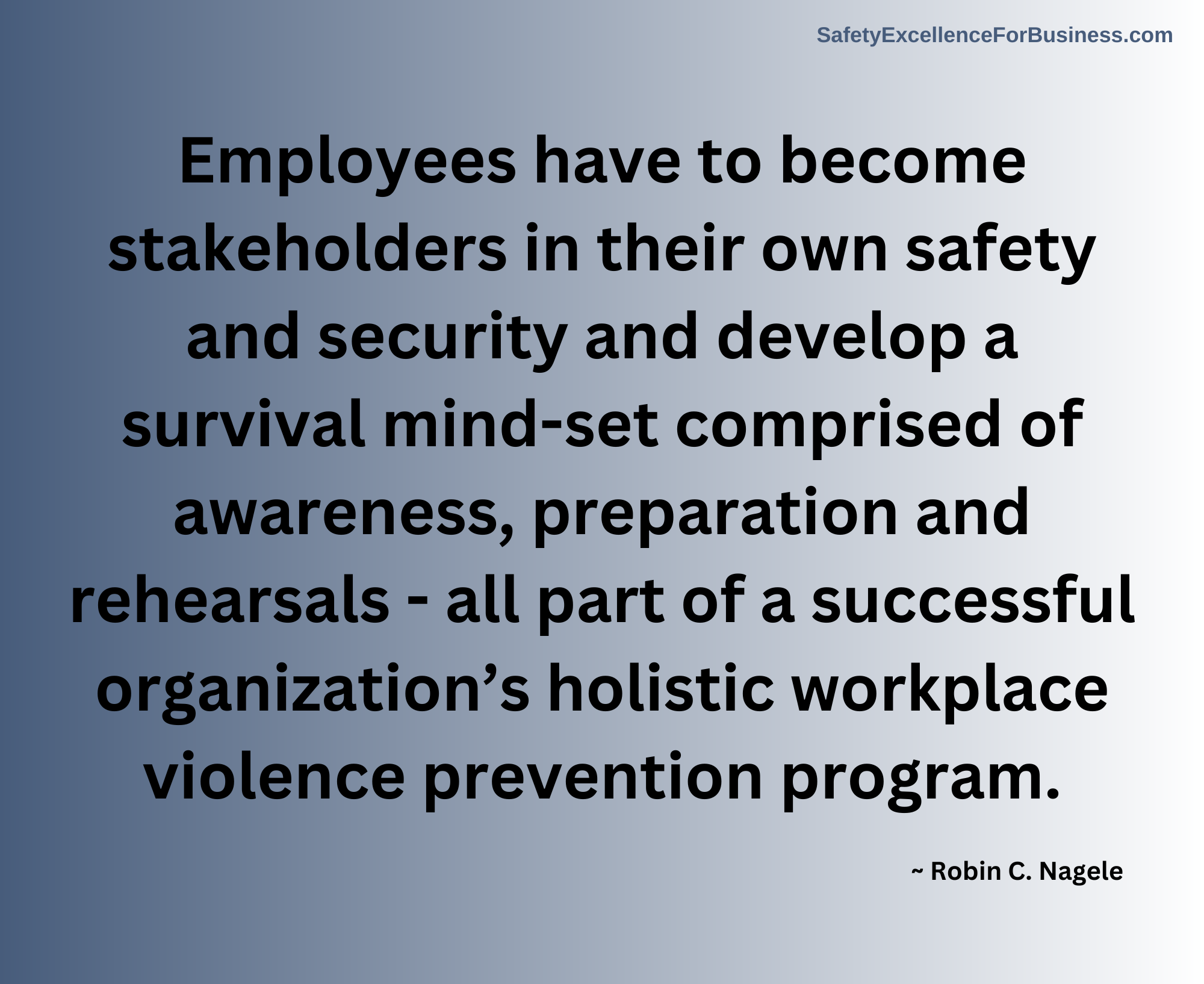What every Manager needs to know that OSHA and ISO already do!
It started out in 1970 with OSHA’s regulations to enhance Safety in the Workplace – the first leg of the Safety Stool, a.k.a. as Occupational Safety, exampled by preventing slips, trips and falls, requiring hearing protection, hand and foot protection, and eye-ware.
Then came the second leg of the Safety Stool, Occupational Health, exampled by preventing environmental/respiratory and ergonomic hazards. Then came Process Safety Management (PSM), exampled by what it takes to keep hazardous substances in the pipes, and which became an essential part of workplace safety with the comprehensive issuance of OSHA 1910 – the third leg.
All three legs are important and are critical for Safety professionals, HR professionals, Managers and Supervisors to embrace and for people to understand. Indeed, OSHA requires this attention to keep our people safe (life and limb) within the workplace.

Now, with this new decade of Workplace Violence rearing its ugly head, we know that we must add a fourth leg to the Safety Stool. Because attention to this 4th prong needs diligent awareness, it is now becoming paramount that every manager and supervisor be schooled in Situational Awareness:
- What is happening around you?
- What is happening between and among people in the workplace?
- Where are your vulnerabilities?
- Are you noticing the cultural dysfunction happening in your workplace?
- Are you able to engage appropriately to find out what’s happening?
- How do you address these dysfunctions?
The fourth leg of this stool is what is called Psychological or Social Safety. Another way to describe it is the psychological harm that comes with repeated bullying, harassment, incivilities, and dysfunctional behaviors, that leave workers dreading to go to work, or that increase the risk of home-growing an active threat/shooter, or having a suicide or murder in your workplace, let alone the bad press that comes with a highly publicized incident.
If no one steps in to stop bad behaviors when they are happening, they continue and escalate over time. Not paying attention to social risk manifests into psychological harm as the continuum of bad behaviors escalate in the workplace – and ultimately can impact people in harmful ways. Yes, OSHA is keen on this 4th leg of the safety stool, too, and wants to know what your business, company, organization, or team is doing about it. Prevention of Workplace Violence is the operative word.
What is Workplace Violence?
OSHA explains that workplace violence is violence or the threat of violence against workers. It can occur at or outside the workplace and can range from threats and verbal abuse to physical assaults and homicide, one of the leading causes of job-related deaths. However it manifests itself, workplace violence is a growing concern for employers and employees nationwide.
OSHA makes it very clear. Employers are responsible for ensuring that the workplace does NOT become a hostile workplace. (Bullying, harassment, and incivilities contribute to hostile environments). OSHA requires employers to provide a safe workplace for their employees…both physically safe and psychologically safe. This is covered by the General Duty Clause Section 5(a)(1).
Enter the new ISO Standard: ISO 45003 IS THE NEW INTERNATIONAL STANDARD (2021-06) – Occupational Health and Safety Management – Psychological health and safety at work – Guidelines for managing psychosocial risks. This new standard states that Management must be prepared to deal with violence that involves a person (employee, visitor, vendor), etc., losing control, without a weapon. This normally means dealing with psychological safety factors.
It is difficult to predict violent acts, so the Standard expects managers and associates to be vigilant. Report any concerns of erratic behaviors to supervision and HR as soon as possible.
Examples of violent behavior include but are not limited to:
- Intimidating or bullying others
- Abusive language
- Physical assault
- Threatening behavior
- Sexual or racial harassment
- Concealing or using a weapon
- Anger
- Tantrums
You get the picture. None of these types of behaviors belong in a workplace, thus the underscoring of new Respectful Workplace policies.

At Nagele, Knowles and Associates, we understand the construct of workplace violence and how to identify it. It starts with knowing your inside culture (culture assessment) to understand where bullying and dysfunctional behavior is happening and how to stop it in its tracks. What is your workplace doing to ensure a Respectful Workplace? It equally starts with a physical security vulnerability assessment to understand where you, your site, your people are most vulnerable to a perpetrator entering your workplace to do harm, and how to deter that from happening.
The 4th leg requires Situational Awareness – that is the tip of the spear when it comes to the prevention of workplace violence…from the inside or from the outside! This holds true in the workplace, and in living our daily lives. Wake up! Be Alert! Observing, expecting, embracing, and requiring a Respectful Workplace is powerful for reducing those harmful dysfunctional behaviors.
Employees must become stakeholders in their own safety and security and develop a survival mindset as well. Vigorous prevention programs, timely interventions, and appropriate responses by organizations and their employees will contribute significantly to a safe, secure, and respectful environment. That’s what we teach; that’s what we do.
Want to know more? Check out our book “Guide to Reducing the Risk of Workplace Violence…the Absolute Essentials” available on Amazon. It has been labeled the “gold standard” – a comprehensive guide to reducing your risk of workplace violence happening in your workplace…from the inside or the outside or give us a call at 716-622-6467.






Speak Your Mind